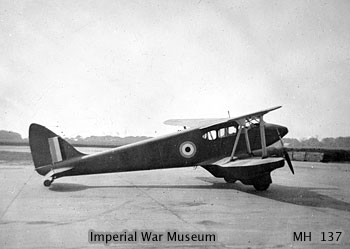- De Havilland Dragonfly
infobox Aircraft
name = DH.90 Dragonfly
type = Light Transport
manufacturer = De Havilland Aircraft Company
caption = R.A.F de Havilland DH.90 Dragonfly AW164 (ex-"G-AEDK") at R.A.F Gosport
designer =
first flight = 1935
introduced = 1936
retired =
produced =
number built = 67
status =
unit cost =
primary user =
more users =
developed from =
variants with their own articles =The de Havilland DH.90 Dragonfly was a 1930s British twin-engined luxury touring biplane built by De Havilland Aircraft Company at
Hatfield Aerodrome .Development
The Dragonfly shared a clear family resemblance with the Dragon Rapide, but was smaller and had higher aspect ratio, slightly sweptback wings. The lower wing had a smaller span than the upper, unlike the DH.89 and the top of the engine nacelles protruded much less above its surface because the fuel tank had been moved to the lower centre section. Structurally, too they were different: the Dragonfly had a new pre-formed plywood monocoque shell and strengthened fuselage. It was designed as a luxury touring aircraft for four passengers and a pilot, with provision for dual control. The first aircraft, "G-ADNA" first flew on the
12 August 1935. The Dragonfly achieved the maximum performance on low power by using the new new construction methods developed for thede Havilland Comet racer and therefore was expensive to buy (£2,650). In modern terms it was an executive transport, aimed at wealthy private individuals often via the companies they owned.Operational History
ref= [Jackson (1978), p.374-9] [Hayes, p.145-50]
The first delivery was made in May 1936. Some thirty-six new build Dragonflies went to private and company owners, about fifteen to airlines/air taxis and three to clubs. Two each went to the Danish and Swedish airforces, and the
Royal Canadian Mounted Police had four to combat rum-runners. Production ended in 1938.By 1939, several aircraft had moved from private to commercial use, like the fleet built up by Air Dispatch Ltd at Croyden (Mrs V. Bruce). Amongst her seven [Haynes p.158] were also some ex-airline machines. They were used as air taxis between the various London airports and also as Army Co-operation night flying trainers. One of the D.H. demonstrators, "CF-BFF" was mounted on
Fairchild floats and used commercially in Canada.At the start of World War II, about twenty-three Dragonflies were impressed into the R.A.F and Commonwealth airforces, some six surviving to 1945. Overall, there were about thirteen flying in that year. By around 1970, only the two survivors noted below were active.
The fuel tanks in the Dragonfly were in the thickened lower centre-section, not immediately behind the engines as in the
Dragon Rapide . As a result, only one aircraft was lost to fire. A common cause of loss was the frequent development of a vicious ground loop either in take-off or landing, resulting in undercarriage write-off and spar damage.Variants
* DH.90 : First prototype only. Two 130 h.p.
de Havilland Gipsy Major I
* DH.90A : Two 142 h.p.de Havilland Gipsy Major 1C or D (postwar, essentially identical) or the earlier, very similar Major II in prewar aircraft.urvivors
Two flyable aircraft survive:
*DH 90A "ZK-AYR" [ [http://www.caa.govt.nz/Script/AirReg3.asp?Mark=AYR&Query3=Get+Reg+Mark Aircraft Registration Mark Query ] ] (c/n 7508) is operated on scenic and aircraft experience flights by the Croydon Aircraft Company [ [http://www.croydonaircraft.com/CAS.html Croydon Aircraft Company] ] in New Zealand. It was first registered as "G-AEDT", then went to Australia as "VH-AAD" and to the USA as "N2034"Jackson (1988) p 471.] . From about 1988 to 1996 it was flying as "G-AEDT" again, before leaving the UK for New Zealand.
*DH 90A "G-AEDU" (c/n 7526) has been registered in the United Kingdom since 1992, owned by the Norman Aeroplane Trust. [ [http://www.caa.co.uk/application.aspx?catid=60&pagetype=65&appid=1&mode=detailnosummary&fullregmark=G-AEDU Civil Aviation Authority Aircraft Register] ] . Originally delivered to Angola in 1937, it flew as "CR-AAB" and later as "ZS-CTR" in South AfricaJackson (1988) p 150.] . When it was returned to England in 1979 it used a British registration ("G-AEDU") that had been allocated to another Dragonfly but not used. It was exported to the United States in 1983 as "N190DH" but it was returned to England in 1992 in a damaged state and rebuilt to flying condition as "G-AEDU".
Former operators
;flag|Australia
*QANTAS ;flag|Canada|1921
*Royal Canadian Air Force
*Royal Canadian Mounted Police ;flag|Denmark
*Royal Danish Air Force ;flag|Egypt|1922
*Misr Airwork Ltd;flagicon|India|British
India
*Air Services of India Ltd;flag|Iraq|1924
*King Faisal of Iraq;flag|Rhodesia
*Rhodesian and Nyasaland Airways;flag|Romania
*LARES ;flag|Sweden
*Royal Swedish Air Force ;flag|Turkey
*Devlet Hava Yollari ;flag|Uruguay
*PLUNA ;flag|United Kingdom
*Air Dispatch Ltd
*Air Commerce Ltd
*Air Service Training Ltd
*Air Taxis Ltd
*Anglo-European Airways Ltd
*Birkett Air Services Ltd
*British Continental Airways Ltd
*International Air Freight Ltd
*Plymouth Airport Ltd
*Royal Air Force
*Silver City Airways Ltd
*Western Airways Ltdpecifications
References
* "The Illustrated Encyclopedia of Aircraft (Part Work 1982-1985)". London: Orbis Publishing.
*Hayes, P & King, B. "de Havilland biplane transports". Coulsden: Gatwick Aviation Society (2003) ISBN 0 95304132 8
* Jackson, A.J. "British Civil Aircraft since 1919, Volume 2". London: Putnam, 1973. ISBN 0-37010-010-7 or (1988 revision) ISBN 0-85177-813-5.
*Jackson, A.J. "De Havilland Aircraft since 1909". London: Putnam, 1978 ISBN 0 370 30022 XExternal links
ee also
aircontent
related=
similar aircraft=
lists=
List of aircraft of the RAF see also=
Wikimedia Foundation. 2010.
